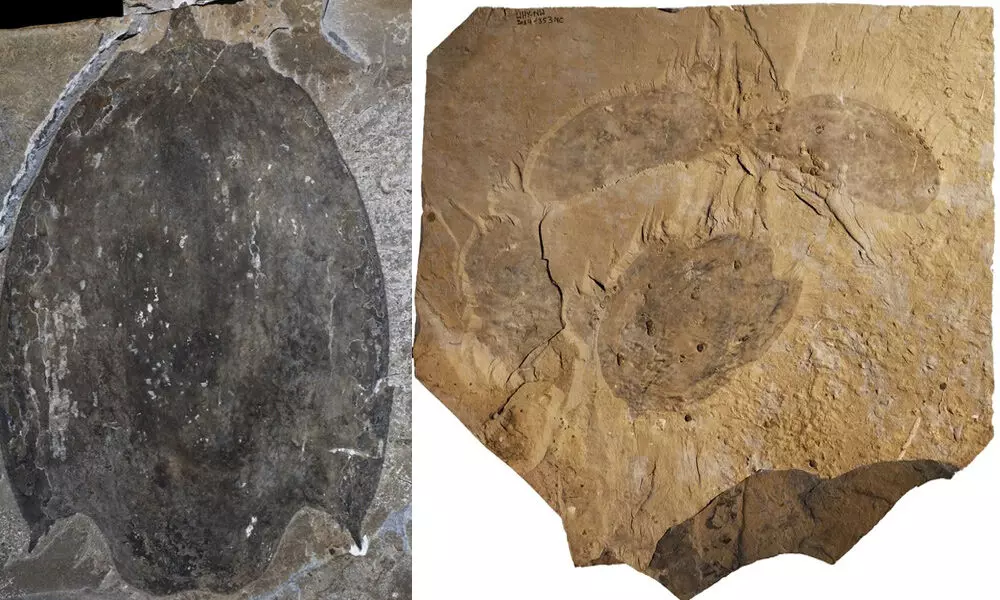Unidentified Cambrian Bug Fossil Has Been Discovered In Eerie Burgess Shale

Fossilized Titanokorys carapace. (Jean-Bernard Caron/Royal Ontario Museum)
- A cambrian colossus recently discovered in the Burgess Shale fossil formation, would have measured a mind-boggling half metre (1.64 feet) in length.
- This is one of the largest Cambrian-era animals ever discovered.
Titanokorys gainesi, a Cambrian colossus recently discovered in the Burgess Shale fossil formation, would have measured a mind-boggling half metre (1.64 feet) in length. That may seem insignificant now, but it was astonishing at a period when practically everything else was less than a sixth of that size.
A giant loomed among the swarms of small bizarre creatures scuttling and swimming across planet Earth 500 million years ago. The animal's sheer size is truly mind-boggling says Royal Ontario Museum palaeontologist Jean-Bernard Caron. This is one of the largest Cambrian-era animals ever discovered.
The Cambrian epoch was a pivotal stage in Earth's evolution. Almost all major kinds of animal life arrived on the scene suddenly around 541 million years ago, over a span of roughly 25 million years, in an event known as the Cambrian explosion. There has never been anything like it before or after.
However, many of the species that arose were very bizarre, at least in comparison to today's existence. If you travelled back in time and saw bristling worms, worms with legs, bizarre jellies, and this unusual monster, you'd be forgiven for believing you'd been transferred to an alien universe.
The imprints of these animals have been preserved as fossils in ancient shale beds, the most well-known of which is the Burgess Shale in Canada. This is also where Caron and his Royal Ontario Museum colleague, palaeontologist Joe Moysiuk, discovered many evidence of this new beast.
Titanokorys' carapace (bottom) and plates that protected the head's underside were fossilised (top).
They were able to identify and characterise the animal in great detail thanks to the excellent preservation characteristics of shale, a sedimentary clay composed of very small particles. It is a member of the radiodonts, a group of extinct Cambrian primitive arthropods that comprised some of the oldest huge predators ever discovered.
The notorious Anomalocaris, regarded to be the earliest known top predator, with a length of up to a metre (3.3 feet), is the largest of these, but Titanokorys isn't far behind.
According to Moysiuk , Titanokorys is a member of the hurdiids, a radiodont subgroup with an unusually tall head and a three-part carapace that has taken on a variety of morphologies .
These animals are little more than swimming heads because their heads are so long in comparison to their bodies.
All radiodonts shared physical characteristics with Titanokorys. It featured multifaceted, stalked compound eyes, a disc-shaped mouth with radiating toothed plates, two long, clawed appendages at the front of its body, and a trunk with many flaps and gills that facilitated swimming.
It's unclear why both the larger predatory radiodonts and the smaller sediment- and filter-feeding radiodonts had these morphological characteristics.
Titanokorys differs from the normal radiodont in one important way: its outer carapace is wider and flatter. This indicates that the animal was nektobenthic, meaning it was adapted to living near the ocean's bottom.
It would have dominated there, the experts believe.
These mysterious animals had a significant impact on Cambrian seafloor ecosystems , Caron added.
Their front limbs looked like a stack of rakes, and they would have been incredibly efficient at transporting whatever they caught in their tiny spines to the mouth. It's possible that the enormous dorsal carapace served as a plough.
The discovery also emphasises the importance of continuing to look, especially for something as well-known and investigated as the Burgess Shale. You never know when a massive Cambrian arthropod will appear right in front of your eyes.














